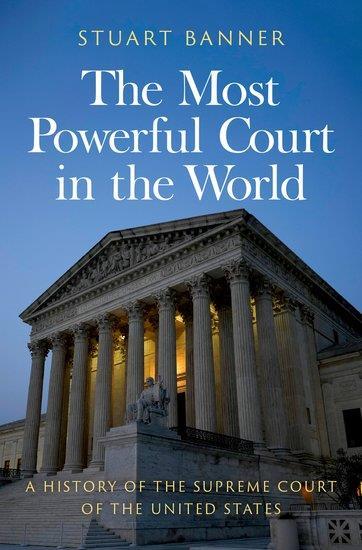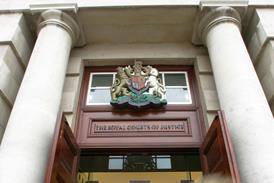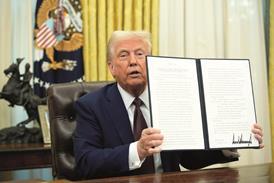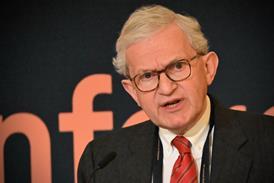The Most Powerful Court in the World
Stuart Banner
£30.99, Oxford University Press
★★★★★
When the French political scientist and writer Alexis de Tocqueville toured the US in the 1830s, he was astonished at how much authority Americans gave their Supreme Court and marvelled, ‘a more imposing judicial power was never constituted by any people’. This fascinating book by Professor Stuart Banner is about how the court acquired so much power, how it has retained its power in the face of repeated challenges, whether it has been as powerful in practice as in theory, and what it has done with its power over the years.
There are nine justices of the Supreme Court. All justices are nominated by the president, confirmed by the Senate, and hold office for life. The first non-white justice was Thurgood Marshall in 1967 and the first female justice was Sandra Day O’Connor in 1981. The court has power to reverse the decisions of state courts and to declare state laws unconstitutional. The Supreme Court’s power is at its peak when it declares statutes unconstitutional. The court has exercised this power of judicial review in its most famous cases, such as Brown v Board of Education and Roe v Wade.
The author explains how, traditionally, the court always blocked social change rather than encouraging it. In 1857, the US was swiftly expanding westward – based on a steadfast belief in its ‘manifest destiny’. The future balance of power in Congress and the future character of the nation depended on the extent to which slavery would be permitted in the western territories. In Dred Scott v Sandford (1857), the justices had a strong interest in preventing the abolition of slavery. Six of the nine justices used the case as a vehicle for forcing the federal government to allow slavery in the territories. Four of the justices used the case to declare that black people were not citizens. This infamous decision was made just four years before the outbreak of the Civil War. The court’s conclusion that Congress could not ban slavery was superseded by the ratification of the Thirteenth Amendment in 1865, which banned slavery throughout the country. The court’s other conclusion, that black people were not citizens, was superseded by the Fourteenth Amendment in 1868. Professor Banner shows us that the Dred Scott case was a ‘self-inflicted wound’ that damaged the court’s reputation and became a salutary tale of the dangers of judicial overreach.

And then, for a brief period, the court became a force for social change. According to the author, if there is a decision that best represents this transformation in the court’s role, it is Brown v Board of Education (1954). The court concluded that ‘in the field of public education the doctrine of “separate but equal” has no place. Separate educational facilities are inherently unequal.’ But Brown did not have an immediate effect and it was only after 1964, when the Civil Rights Act allowed the federal government to withhold funding from segregated school districts, that the number of black children attending school with white children increased significantly.
The court cannot, in the opinion of Professor Banner, engineer much social change without the cooperation of the other two branches of government. Another example of the court as facilitator of progressive change is Roe v Wade (1973) in which the court declared a woman’s constitutional right to have an abortion. However, this decision sparked the emergence of a political movement devoted to prohibiting abortion. All future nominees to the court were scrutinised on whether they would overrule or reaffirm Roe v Wade. Roe would be the last of the court’s major mid-century liberal decisions and, in 2022, the court overruled Roe on the grounds that the right to abortion was not ‘deeply rooted in the nation’s history or tradition’.
The most illuminating aspect of the book, for this reader, is Professor Banner’s analysis of how political calculations have always played a part in the selection and appointment of justices. Of the 19 new justices appointed between 1937 and 1967, 14 were appointed by Democrat presidents leading to the liberal transformation of the court in the middle of the last century. Then, between 1969 and 1991, 10 consecutive justices were appointed by Republican presidents; Jimmy Carter is the only president in American history to serve a full term but never have the opportunity to appoint a justice. These justices were selected to undo the changes brought about by the ‘liberal Court’. When the president’s party has not controlled the Senate, the Senate has never confirmed any of the president’s nominees during the final year of his administration. For example, Senate Republicans kept a seat on the court open for more than a year after Antonin Scalia died so Barack Obama could not appoint his replacement.
Today, the court’s decision in Brown is met with almost universal approval, but it was intensely controversial in its day. Even among those who supported integration, many thought it was a goal that should be achieved through political means, not by the decree of nine unelected judges. The justices insist they are not policymakers in robes but, in cases like abortion, it is hard to take these assertions seriously. When cases involve politically controversial questions, and when governing law can be interpreted in more than one plausible way, the justices reach outcomes consistent with their policy preferences.
This book is full of insights on the history and development of ‘the most powerful court in the world’.
Kevin McVeigh is a partner at Elliott Duffy Garrett Solicitors, Belfast





























No comments yet